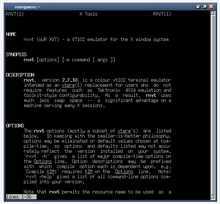Manpage


Man pages (after the Unix command man , which stands for English manual " manual ") are a collection of help and documentation pages for Unix and related operating systems . They are searched and output with the commands manand whatis. A separate index, the so-called Whatis database, is created for quick screening. Man pages are created with the help of the specially designed Macro package manwith the Unix system tool troff.
construction
Structure, sections
To a large extent, man pages are expressly not standardized by the POSIX standard (IEEE Std 1003.1), but standardization was only carried out for the absolutely necessary minimum. However, a division into so-called sections (chapters, areas) similar to that found on most Unix derivatives has become established, which is based on the original division.
For example, here are the sections under AIX (title in Locale C ):
- (1) User Commands and Daemons ("User commands and background services")
- (2) System Calls and Kernel Services (" System Calls and Services")
- (3) Subroutines ("subroutines")
- (4) Special Files, Device Drivers and Hardware ("Devices")
- (5) Configuration Files ("configuration files")
- (6) Games ("Games")
- (7) Miscellaneous Commands
- (8) Administrative Commands and Daemons ("Administration")
The notation jail(8) refers to the manual page of the FreeBSD system administration command jail , whereas the notation jail(2)refers to the manual page of the FreeBSD system call jail .
Structure of individual man pages
An informal convention similar to that used for the chapters has also become established for the structure of the individual articles. Only systems that obtain their system commands from the GNU initiative (Linux, FreeBSD etc.) deviate strongly from this convention because the GNU project tries to replace man pages with alternatives ( Texinfo ) that they consider better . However, there are also man pages for programs that do not include this type of documentation, as such have been created for individual Linux distributions (the Debian project stipulates that all programs should have a man page); in many cases, however, these are only brief descriptions, sometimes out of date, mostly only available in English , and they are not supplied with every system.
A man page is typically divided into the following areas; sections in brackets are optional:
SURNAME
- Name of the program followed by a one-line short description.
SYNOPSIS
- For programs, a complete list of parameters and options is described here.
DESCRIPTION
- A text description of how the command or function works. (Usually not of use, see below.)
OPTIONS / FLAGS
- A list of options and their valid arguments, usually in alphabetical order.
(USAGE)
- Instructions for using the program.
EXIT STATUS
- Description of possible return values and their meaning.
(EXAMPLES)
- Some examples of usage.
(FILES)
- If certain files (e.g. configuration files) are involved in the function of the program or are affected by the execution of the same, they are listed here and their function is described.
SEE ALSO
- A list of similar or related commands or functions; for affected files, reference is made to the corresponding entries in Section 5.
handling
Man pages in certain sections are usually referred to in the form of entry title ( N ) , where N is the section number, such as syslogd (1) or syslogd (8) . Most programs have only one section. If manno section number is specified when calling up , the first section found is displayed.
As standard /usr/share/man, the man pages are subordinate to individual documents , namely in a defined directory hierarchy, which maps the locale (local language translations of the documents that are generally written in English), section, etc. The manenvironment variable is MANPATHunderstood by most implementations of , but its use is expressly not covered by the POSIX standard.
With the command apropos , which is often a wrapper or alias for man -k, you can search the Whatis database for keywords. The answer is a list of the entries found, including the section number, which can manthen be passed as an argument when you call up again .
Web links
- Ken Thompson , Dennis Ritchie : Unix Programmer's Manual. Lucent Technologies, November 3, 1971, accessed on September 10, 2017 (the first edition of the Unix Programmer's Manual dated November 3, 1971 is available here as scan, Postscript and PDF file formats).
-
BSD :
man(1)- OpenBSD General Commands Manual -
GNU :
man(1)- Debian GNU / Linux Executable programs or shell commands man page -
POSIX :
man- Open Group Base Specification - more man pages for other operating systems like AIX , HP-UX , IRIX , Minix ,…, Xenix
Individual evidence
- ↑ a b man specification of the Open Group. Retrieved April 17, 2013 .
- ↑ freebsd.org
- ↑ freebsd.org
- ↑ The number in brackets behind the name of the command follows the division into ten FreeBSD manpage sections ("areas"), these are: (1) general commands, (2) system calls, (3) subroutines, (4) special files, ( 5) file formats, (6) games, (7) macros and conventions, (8) maintenance commands, (9) kernel interface, (n) new commands.
- ↑ a b File System Hierarchy Standard (FHS). Retrieved April 17, 2013 .
